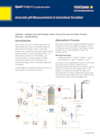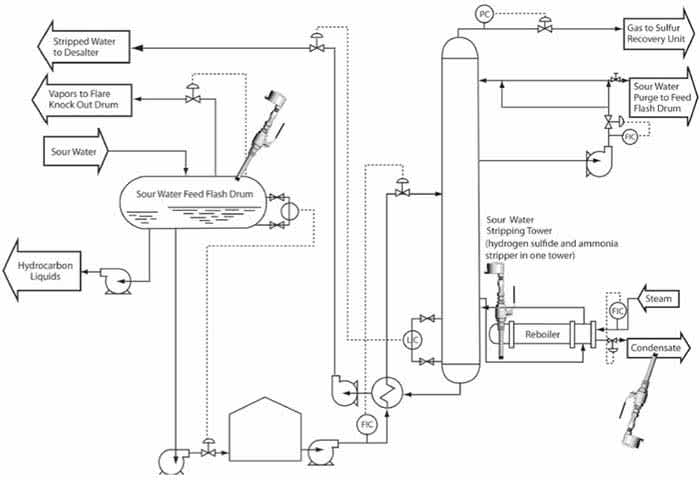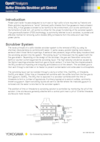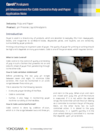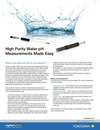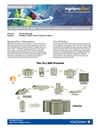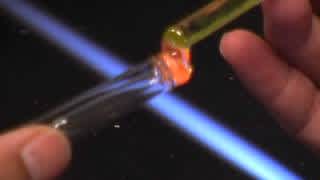The heart of a pH measuring loop is the electrode system. Yokogawa has designed a wide range of electrodes to ensure this heart keeps beating under the most severe conditions. The dimensions and design meet the requirements of DIN 19263 (excluding the refillable types). A high degree of standardization makes it possible to mount any electrode in the standard program of fittings. Color coded strips on electrode and cable and clear identification of sensor specifications make incorrect installation virtually impossible.
- Wide range of electrodes to suit all process conditions.
- Gold plated spring connector parts, for good electrical contact under the most severe conditions.
- Coaxial plug and socket with watertight sealing that meets the requirements of IP65.
- Color coded strips for easy identification of electrodes and cables.
- High degree of standardization for mounting in flow- and immersion fittings
Details
-
Hot-Tap Holder PR10
Universal retractable assembly for all liquid measurements
-
Flow/NPT Fittings FF20/FS20
FF20/FS20 Fittings for pH and ORP
-
Immersion Holder FD20
The immersion fittings are designed for either pH or ORP (Redox) measurements in tanks, open vessels and drains. They have a "hoisting cable" for easy maintenance.
Resources
Wet scrubbers are used in utilities, paper mills, and chemical plants to remove sulfur dioxide (SO2) and other pollutants from gas streams. Undesirable pollutants are removed by contacting the gases with an aqueous solution or slurry containing a sorbent. The most common sorbents are lime, Ca(OH)2, and limestone, CaCO3.
For control of batch neutralization, a pH measurement coupled with a timer-controlled chemical feed scheme provides very satisfactory results.
This system can be adapted for either acid waste or alkaline waste neutralization.
Measurement of pH in high purity water presents many difficulties. Yokogawa's pH instrument's design success comes from addressing the unique challenges of the application.
Process liquid analyzers such as pH meters, conductivity meters, ORP meters, and density meters play an important role at electrolysis plants in the control of concentrations of various process solutions. This requires both precision and stability under harsh conditions that include highly corrosive substances, high temperatures, and many impurities.
Sour Water is the wastewater that is produced from atmospheric and vacuum crude columns at refineries. Hydrogen sulfide and ammonia are typical components in sour water that need to be removed before the water can be reused elsewhere in the plant.
Power plant boiler houses designed to burn coal or high sulfur oil are required by Federal and State pollution regulations to "scrub" (remove) sulfur dioxide from flue gasses to meet emission limits. SO2 in flue gasses is known to be harmful to the environment, as it is one contributor to the formation of acid rain. pH control is critical for the proper functioning of the scrubber system.
The quality of paper for printing or writing should be high and it depends on many parameters. Cobb is one of the parameters, which requires control. Using a retractable fitting, this optimum pH level can be achieved by using Yokogawa's 4-wire pH Analyzer with a suitable, retractable fitting and sensor. Since a separate controller is not required for the dosing pump, this solution provides a cost-saving.
Wastes have been considered to be a serious worldwide environmental problem in recent years. Because of increasing pollution, these wastes should be treated. However, industrial wastes can contain a number of valuable organic components. Recovery of these components is important economically. Using conventional distillation techniques, the separation of acetic acid and water is both impractical and uneconomical, because it often requires large number of trays and a high reflux ratio. In practice special techniques are used depending on the concentration of acetic acid.
Ultrapure water, UPW, high-purity water and deionized (DI) are all terms describing basically the same property. They refer to water which has been purified to the highest standards by removing all contaminants such as, organic and inorganic compounds; dissolved and particulate matter; volatile and non-volatile, reactive and inert; hydrophilic and hydrophobic; and dissolved gases. The purified water has very low conductivity which means it is high in resistance because all the conductive components have been removed. In low conductive solutions combined with its susceptibility to contamination and temperature effects makes accurate pH measurement very difficult.
Many Ethanol plants running today are using a combination style pH electrode with a non-flowing reference to measure pH in the Mash Slurry transfer line from the Mash slurry mix tank to cook. The Mash is being pumped out of the Mash Slurry tank is at approximately 180 °F and 40 to 60 psig.
Optimizing four key factors will decrease pH sensor costs and optimize process control and overall plant efficiency.
Current trend for increasing mercury awareness throughout the public sector has caused the government to take action. Recently, the Environmental Protection Agency (EPA) has focused their efforts on controlling mercury levels produced in various coal fired power plants. Based on information from several case studies, the EPA developed the Mercury and Air Toxics Standards to cut back mercury emissions. The most popular technology utilized by coal plants to meet the new standards is a scrubber which cleans the off gas from the combustion process. ORP sensors can further monitor the effluent from these scrubbers to ensure optimal mercury emission levels are achieved. By closely monitoring the mercury concentrations in the effluent, plant managers will be able to easily confirm their plants are meeting the EPA's standards.
By understanding what causes the difficulties in pH measurements and having the proper equipment, stable and accurate pure water pH measurement can be accomplished.
The lifetime of a pH sensor has a significant impact on the overall annual costs of a pH measuring loop. Optimizing four key factors will decrease these costs and optimize process control and overall plant efficiency.
- Ammonia
- Base Chemical
- Biomass Power
- Chemical
- Chlor-Alkali
- Cogeneration
- Combined Cycle
- Desalination
- Drinking Water Treatment
- Energy Transition
- Food & Beverage
- Geothermal Power
- Hydro Power
- Industrial Water
- Iron & Steel
- LNG Liquefaction
- LNG Regasification & Storage
- LNG Supply Chain
- Methanol
- Mining & Metal
- Nuclear
- Ocean Thermal Energy Conversion
- Oil & Gas Downstream
- Petrochemical
- Pharmaceutical
- Power
- Processing & Fractionation
- Pulp & Paper
- Refining
- Specialty & Fine Chemical
- Water & Wastewater
Kind of. Calibration itself will not extend the life of a sensor, however, a sensor that is not calibrated properly can cause unreliable measurements - that are often misdiagnosed leading to unnecessary replacements.
- Ammonia
- Base Chemical
- Biomass Power
- Chemical
- Chlor-Alkali
- Cogeneration
- Combined Cycle
- Desalination
- Drinking Water Treatment
- Energy Transition
- Food & Beverage
- Geothermal Power
- Hydro Power
- Industrial Water
- Iron & Steel
- LNG Liquefaction
- LNG Regasification & Storage
- LNG Supply Chain
- Methanol
- Mining & Metal
- Nuclear
- Ocean Thermal Energy Conversion
- Oil & Gas Downstream
- Petrochemical
- Pharmaceutical
- Power
- Processing & Fractionation
- Pulp & Paper
- Refining
- Specialty & Fine Chemical
- Water & Wastewater
Optimizing the maintenance cycle is not always straightforward. In some cases, cleaning once a week is sufficient and other processes may require every 8 hours.
- Ammonia
- Base Chemical
- Biomass Power
- Chemical
- Chlor-Alkali
- Cogeneration
- Desalination
- Drinking Water Treatment
- Energy Transition
- Food & Beverage
- Geothermal Power
- Hydro Power
- Industrial Water
- Iron & Steel
- LNG Liquefaction
- LNG Regasification & Storage
- LNG Supply Chain
- Methanol
- Mining & Metal
- Nuclear
- Ocean Thermal Energy Conversion
- Oil & Gas Downstream
- Petrochemical
- Pharmaceutical
- Power
- Processing & Fractionation
- Pulp & Paper
- Refining
- Specialty & Fine Chemical
- Water & Wastewater
Learning these four lessons will help you improve your engineering skills and most importantly extend the life of your pH sensors.
- Ammonia
- Base Chemical
- Biomass Power
- Chemical
- Chlor-Alkali
- Cogeneration
- Combined Cycle
- Desalination
- Drinking Water Treatment
- Energy Transition
- Food & Beverage
- Geothermal Power
- Hydro Power
- Industrial Water
- Iron & Steel
- LNG Liquefaction
- LNG Regasification & Storage
- LNG Supply Chain
- Methanol
- Mining & Metal
- Nuclear
- Ocean Thermal Energy Conversion
- Oil & Gas Downstream
- Petrochemical
- Pharmaceutical
- Power
- Processing & Fractionation
- Pulp & Paper
- Refining
- Specialty & Fine Chemical
- Water & Wastewater
Select the correct pH glass and reference type to improve your pH sensor lifetime and you can limit or even eliminate the effects of temperature and pressure on especially the reference sensor.
- Ammonia
- Base Chemical
- Biomass Power
- Chemical
- Chlor-Alkali
- Cogeneration
- Combined Cycle
- Desalination
- Drinking Water Treatment
- Energy Transition
- Food & Beverage
- Geothermal Power
- Hydro Power
- Industrial Water
- Iron & Steel
- LNG Liquefaction
- LNG Regasification & Storage
- LNG Supply Chain
- Methanol
- Mining & Metal
- Nuclear
- Ocean Thermal Energy Conversion
- Oil & Gas Downstream
- Petrochemical
- Power
- Processing & Fractionation
- Pulp & Paper
- Refining
- Specialty & Fine Chemical
- Water & Wastewater
Downloads
Brochures
Instruction Manuals
- Model SC21series, SC29 series - pH / redox combined electrodes (1.3 MB)
- Directions for use Redox Electrodes (1.7 MB)
- Direction for use combined pH and Redox electrodes (1.0 MB)
- Directions for use pH electrodes (1.2 MB)
- Directions for use reference Electrodes (2.1 MB)
- SM23 Sodium Sensor (1.4 MB)
- Model FF20 Flow fittings Model FS20 Subassembly flow fittings Model FD20 immersion fitting (3.4 MB)
- Model SC25V Combined pH sensor (881 KB)
- Directions for use Temp. Electrodes (1.7 MB)
General Specifications
- Model PF20, PD20 and PS20 EXA Compact pH Probes (1.3 MB)
- Model SM21 Industrial pH Electrodes (499 KB)
- Model SR20 Single reference electrode (pH) (2.3 MB)
- SM60 Industrial electrodes for temperature measurement (566 KB)
- SM23 Industrial electrodes for single pNa measurement (931 KB)
- Model SC29 Industrial Redox Electrodes (930 KB)
- Model SC21 Industrial pH Electrodes (702 KB)
- Model SC25V Combined pH electrode (1.2 MB)
- Models FF20, FS20 and FD20 Flow, Subassembly and Immersion Fittings for pH/ORP (Redox) measuring loops (3.2 MB)
Technical Information
- FLEXA/EXA PH Series Process pH Analyzers Measurement System and Applications (2.4 MB)
- Best Practice Layup Procedure Guide (315.8 KB)
- Bellomatic Guide - solving pH challanges, commissioning and refilling of flowing type pH reference sensor (SR20-AC32) (986 KB)
- Best Practice pH Installation and Maintenance Manual (824.1 KB)
- A Word About Buffers
- Care & Maintenance in High Purity Water (85 KB)
- Temperature Compensation (115 KB)
- Wet vs Dry Electrodes, Problems and Solutions (111 KB)
Certificates
- EU_UK Declaration of Conformity SM21_SM23 2022-10-03 (126.3 KB)
- EU_UK Declaration of Conformity SB20_SM29_SM60_SR20 2022-10-03 (167.1 KB)
- EU_UK Declaration of Conformity SC21_SC29 2022-10-03 (162.4 KB)
- Manufacturing Statement SC21 (91.1 KB)
- Manufacturing Statement SC29 (85.3 KB)
- Manufacturing Statement SM21 (85.8 KB)
- Manufacturing Statement SR20 (81.6 KB)
- Manufacturing Statement SM60-T1 (75.9 KB)
- Mercury Free Declaration (101 KB)
- Shelf Life Statement (39.8 KB)
MSDS/SDS
- Safety Data Sheet K1220QT / Electrolyte for individual and combined pH and ORP sensors
- K1520VA / KCl solution 3.3 M (114.4 KB)
- K1520VN / KCl solution 3.3 M thickened (114.4 KB)
- 238228 - HAMILTON 271 mV ORP Buffer Solution (113 KB)
- K1520BG - 2.00 pH buffer solution with Na (51 KB)
- K1520BH - 4.00 pH buffer solution with Na (48 KB)
- K1520BJ - 7.00 pH buffer solution with Na (48 KB)
- K1520BK - 9.00 pH buffer solution with Na (48 KB)
- NIST Buffer Solutions: M1100EU, M1200HQ, M1200HR, M1200HS, M1263VM, M1263VN, M1263VP (223 KB)
Videos
Glass blown pH electrodes at Yokogawa Europe.
How to install a Bellomatic probe in a holder and perform necessary maintenance.
Looking for more information on our people, technology and solutions?
Contact Us
